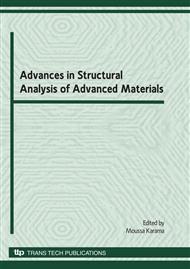[1]
S.A. Tobias, W. Fishwick, A Theory of Regenerative Chatter, The Engineer, London (1958).
Google Scholar
[2]
J. Tlusty, Manufacturing Processes and Equipment, Prentice Hall, New Jersey (2000).
Google Scholar
[3]
H.E. Merritt, Theory of Self-Excited Machine-Tool Chatter, ASME J. Eng. Ind., 87 (1965) 447-454.
DOI: 10.1115/1.3670861
Google Scholar
[4]
J. Tlusty, Analysis of the State of Research in Cutting Dynamics, CIRP Ann., 27/2 (1978) 583-589.
Google Scholar
[5]
F.N. Saravanja and A.F. D'Souza, Experimental and Analytical Investigation of Self-Excited Chatter Vibrations in Metal Cutting, ASME J. Eng. Ind., 96, nº2 (1978) 670-675.
DOI: 10.1115/1.3453900
Google Scholar
[6]
E. Ozlu, E. Budak, Analytical prediction of stability limit in turning operations, in: Proceedings of the Ninth CIRP International Workshop on Modeling of Machining Operations, Bled, Slovenia, May (2006).
Google Scholar
[7]
R.N. Arnold, The mechanism of tool vibration in the cutting of steel, Inst. Mech. Eng. J. Proc., 154 (1946) 261.
Google Scholar
[8]
B.E. Clancy, B. Rao, Y.C. Shin, Mechanistic force modeling with time-dependent characteristics due to tool wear for face turning of Ni-based super alloys, Transactions of the NAMRI/SME 29 (2001) 311-318.
Google Scholar
[9]
Y. Altintas et al., Identification of dynamic cutting force coefficients and chatter stability with process damping, CIRP Annals - Manufacturing Technology 57 (2008) 371-374.
DOI: 10.1016/j.cirp.2008.03.048
Google Scholar
[10]
R.L. Kegg, Cutting dynamics in machine tool chatter, Contribution to Machine tool Chatter Research 3. Transactions of ASME Journal of Engineering for Industry 87 (1965) 464-470.
DOI: 10.1115/1.3670863
Google Scholar
[11]
K. Mehdi et al., Dynamic behavior of a thin-walled cylindrical workpiece during turning process, Part 1: Cutting process simulation, Transactions of the ASME 124 (2002) 562-568.
DOI: 10.1115/1.1431260
Google Scholar
[12]
J. Tlusty, M. Polacek, The stability of machine tools against self-excited vibrations in machining, Int. Res. Prod. Eng. ASME (1963) 465-474.
Google Scholar
[13]
I. Minis, T. Yanushevsky, A new theoretical approach for the prediction of the machine tool chatter in milling, ASME J. Eng. Incl. 115 (1993) 1-8.
DOI: 10.1115/1.2901633
Google Scholar
[14]
F. Kuster, Cutting dynamics and stability of boring bars, CIRP Annals 39 (1) (1990).
DOI: 10.1016/s0007-8506(07)61073-7
Google Scholar
[15]
T. Kaneko et al., Self-excited chatter and its marks in turning, Trans. ASME 222 (1984) 106228.
Google Scholar
[16]
C.B. Rao and Y.C. Shin, A comprehensive dynamic cutting force model for chatter prediction in turning, Int. J. Mach. Tools Manuf. 39 (1999) 1631-1654.
DOI: 10.1016/s0890-6955(99)00007-3
Google Scholar
[17]
E. Budak and Y. Altintas, Analytical prediction of chatter stability in milling-part I: general formulation; part II: application to common milling systems, ASME J. Dyn. Sys. Meas. Control 120 (1998) 22-36.
DOI: 10.1115/1.2801318
Google Scholar
[18]
K. Mehdi et al., Dynamic behavior of a thin-walled cylindrical workpiece during turning process, Part 2: Experimental approach and validation, Trans. ASME 124 (2002) 569-580.
DOI: 10.1115/1.1432667
Google Scholar
[19]
U. Bravo et al., Stability limits of milling considering the flexibility of the workpiece and the machine, Int. J. Mach. Tools Manuf. 45 (15) (2005) 1669.
DOI: 10.1016/j.ijmachtools.2005.03.004
Google Scholar
[20]
F. Campa et al., Definition of cutting conditions for thin-to-thin milling of aerospace low rigidity parts, Proceedings of the 2008 International Manufacturing Science and Engineering Conference MSEC2008, Illinois, USA, October (2008).
DOI: 10.1115/msec_icmp2008-72200
Google Scholar
[21]
E. Budak and E. Ozlu, Analytical Modeling of Chatter Stability in Turning and Boring Operations: A Multi-Dimensional Approach, CIRP Annals - Manuf. Tech. 56 (1) (2007) 401.
DOI: 10.1016/j.cirp.2007.05.093
Google Scholar


